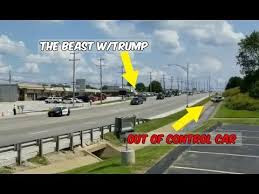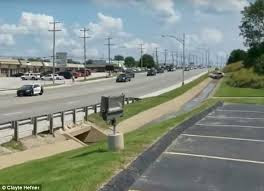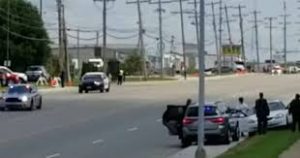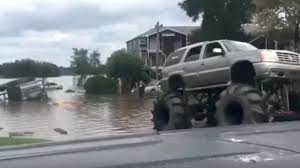Article author: Miky Weinberg – Owner of the Tarantula Technologies Ltd and Octagon Security Ltd Companies.
US President Donald Trump visited Springfield when during his ride in the long, massive and secure presidential convoy a vehicle burst to the left of the convoy, and here (referring to the direction of travel) a white private vehicle eventually stopped on the side parallel to the presidential vehicle.
the event was filmed:
Photography from another angle:
In close protection, securing the principal during vehicular movements is considered on the one hand difficult and challenging and on the other hand, there are numerous options in response to the possible threats. One of the threats is an adversary operating with the help of a vehicle that allows him to collide with the principal’s vehicle as a fatal accident (this has happened before), collide and operate the vehicle as a car bomb (this has happened before), block the principal’s vehicle and start shooting (this has happened before) and more.
The incident in question illustrates the adversary’s ability to succeed and surprise because it may be considered the least logical and predictable because of the ditch located on the side of the road and perhaps because of the wooded area adjacent to it, and indeed it can be seen that no security forces are stationed on this side of the road.
At the end of the event it turned out that he was a completely innocent person who happened to be where he was when the presidential convoy passed, but can this be assumed to be the reason for the visible action in real-time, while the incident is taking place? Can the security personnel in the convoy act in what appears to be indifference just because the vehicle stopped and did not continue to gallop on its way to the President’s vehicle? Of course not.
The rule in security states that in identifying an exceptional event, the security system must act quickly and decisively in order to be able to classify it correctly, choose the right actions, and all this within the framework of securing the president. In my opinion, the reaction of the President’s protection team is very worrying because of the slowness and indifference that is clearly visible from the moment the event begins and also because of the professional mistakes related to securing a person in a vehicular convoy.
The following images illustrate the security response issues:
Photo 1:
The moment the vehicle appears in coordination to the left of the convoy. Note that at this point the vehicle is parallel to the president’s possible location in the convoy. This is the moment when the security array is required to first identify and classify the incident.
Event classification at this point – vehicle bursting in from the left.
This is an incident that is defined as very unusual that requires a quick and determined response from the security array.


Photo 2:
The security vehicle that goes to handle the incident – at this stage the force whose job it is to act against threats of this kind, is required to act quickly and resolutely until a complete and correct appraisal of the situation is complete and the threat neutralized according to the threat and legal powers that are available to the security team. The problem is that from what is seen in the video and image, the behavior of the responding force is far from professional when it comes to close protection.
The required response: Arrival with a security vehicle, stopping at a tactical distance and in a place that prevents the vehicle from continuing to travel, unloading security personnel from the vehicle with weapons drawn and alert and fearful of the possibility of an exploding vehicle and an adversary who can escape, shoot or himself explode.

The behavior of the security team is reminiscent of a traffic cop arresting a citizen for a traffic offense and not the security team of the President of the United States facing a vehicle that appears to be bursting towards the convoy.
Let’s watch the video in slow motion and conclude:
The incident once again illustrates how the potential adversary is surprising in arriving, approaching the object of security, and ultimately in the action, he has chosen to take against him. The incident shows how a security array must not act against a potential threat and once again emphasizes the fact that today almost every incident is filmed by the media or by citizens and shortly after its occurrence it already appears on social media.
In vehicular close protection, there are a number of responses against existing threats such as armored vehicles, identical vehicles in the convoy, changing the principal’s position in the convoy, and security vehicles for concealment and providing a quick response against any threat. The vehicle that first responded to the incident has to continue handling the bursting vehicle and not continue driving and send another vehicle a long time afterward.
In the above case, it is a small private vehicle that probably would not really have been able to reach the Presidential vehicle, but what would have happened if it had been a larger vehicle that would have crossed the ditch without any problem and managed to accelerate in a very short time towards the Presidential vehicle?
Such a vehicle for example:

In vehicular security, as long as the traffic lane is open and not blocked, the best response is to continue a fast forward ride with the principal’s vehicle.
I wish for the President of the United States that all the anomalous events around him have turned out to be innocent and especially that his security array will respond more quickly and decisively than the level of response demonstrated in the event in question.
Another example of a weak response from a close protection system:
During the security of the President of Morocco in a vehicular movement, a man burst towards the convoy and reached as far as the President’s vehicle without any of the security personnel interrupting him. Here, too, the security system does not appear to have responded as required in such situations – rescue in fast-moving driving forward. What is certain is that the best reaction is to stop the principal’s vehicle!
the event’s video:
Remember that security must be maintained quickly and resolutely against all threats until they are neutralized and finally classified.